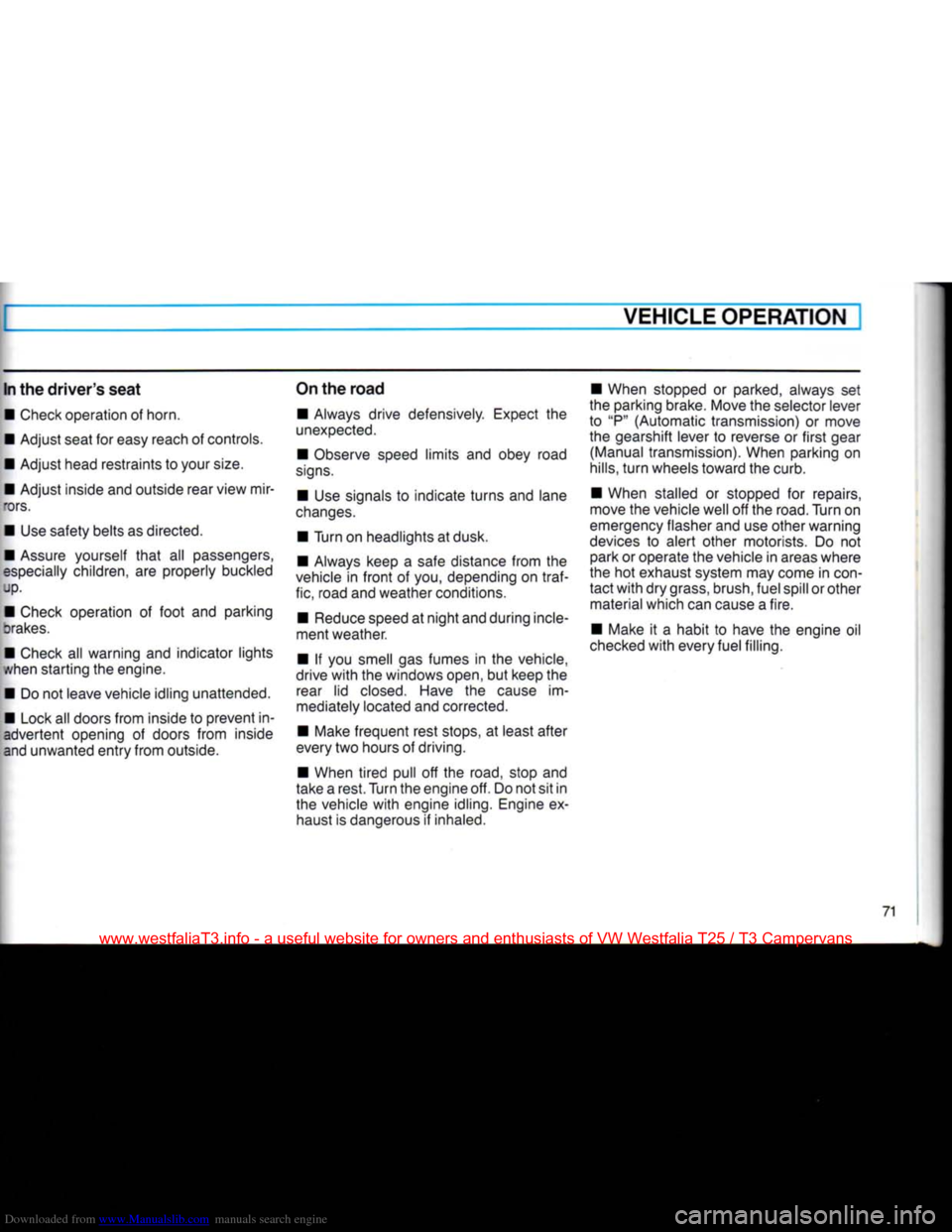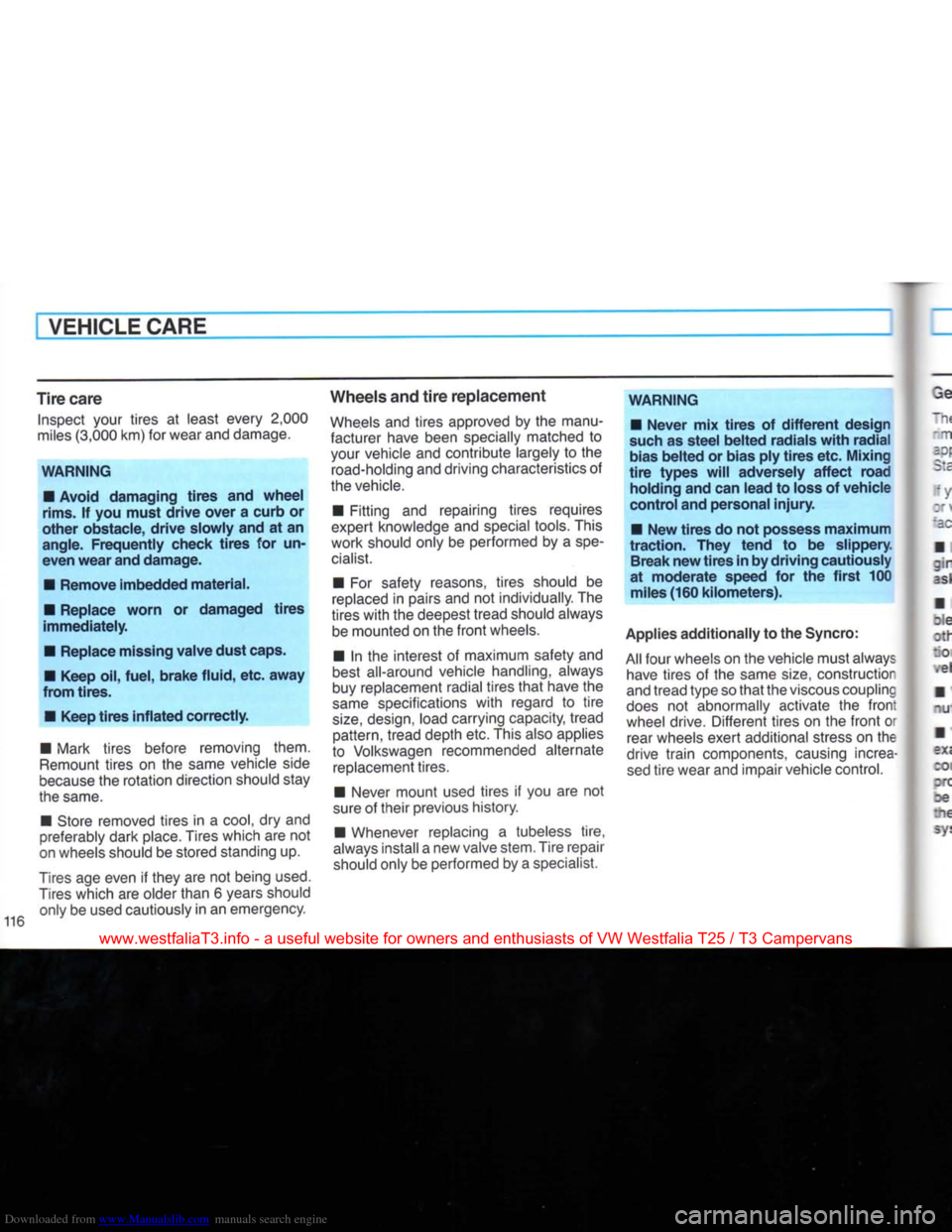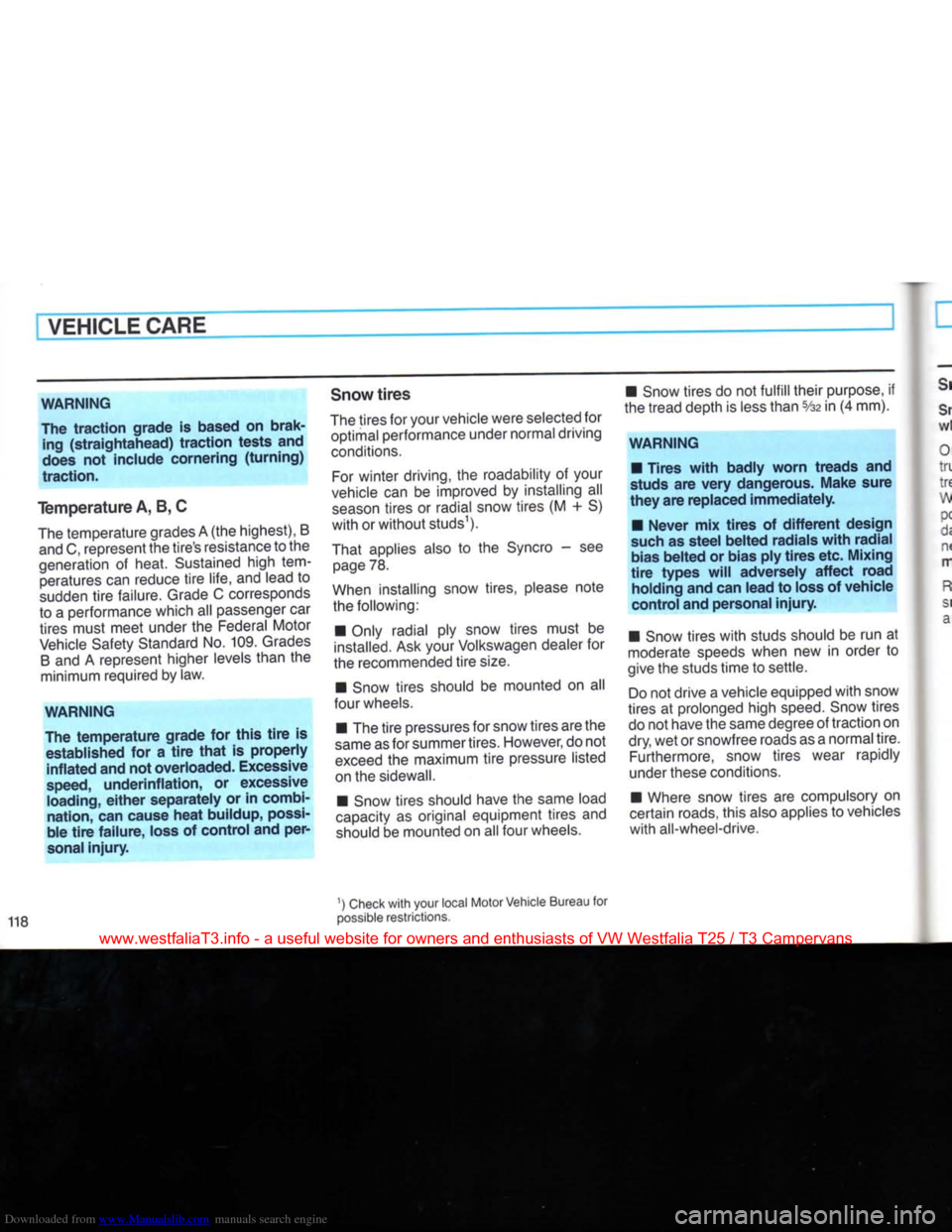1990 VOLKSWAGEN TRANSPORTER wheel size
[x] Cancel search: wheel sizePage 72 of 165

Downloaded from www.Manualslib.com manuals search engine
VEHICLE
OPERATION
In the
driver's
seat
•
Check operation of horn.
•
Adjust seat for easy reach of controls.
•
Adjust head restraints to your
size.
•
Adjust inside and outside rear view mir-
brs.
•
Use safety belts as directed.
•
Assure yourself
that
all passengers,
especially
children, are properly buckled up.
•
Check operation of
foot
and parking
orakes.
•
Check all warning and indicator lights
v/hen starting the engine.
•
Do not leave vehicle idling unattended.
•
Lock all doors
from
inside to prevent in advertent opening of doors
from
inside
and unwanted
entry
from
outside. On the
road
•
Always drive defensively. Expect the
unexpected.
•
Observe speed
limits
and obey road
signs.
•
Use signals to indicate
turns
and lane
changes.
•
Turn on headlights at dusk.
•
Always keep a safe distance
from
the
vehicle in
front
of you, depending on
traf
fic, road and weather conditions.
•
Reduce speed at
night
and during incle
ment weather.
•
If you smell gas fumes in the vehicle,
drive
with
the windows open, but keep the rear lid
closed.
Have the cause im
mediately located and corrected.
•
Make frequent rest stops, at least
after
every two hours of driving.
•
When
tired
pull off the road, stop and
take a rest. Turn the engine off. Do not sit in the vehicle
with
engine idling. Engine exhaust is dangerous if inhaled.
•
When stopped or parked, always set
the parking brake. Move the selector lever
to "P" (Automatic transmission) or move
the gearshift lever to reverse or
first
gear (Manual transmission). When parking on
hills,
turn
wheels
toward
the curb.
•
When stalled or stopped for repairs,
move the vehicle well off the road. Turn on
emergency flasher and use other warning
devices
to alert other motorists. Do not park or operate the vehicle in areas where
the hot exhaust system may come in
con
tact
with
dry
grass,
brush, fuel spill or other material which can cause a fire.
•
Make it a habit to have the engine oil
checked
with
every fuel filling.
www.westfaliaT3.info - a useful website for owners and enthusiasts of VW Westfalia T25 / T3 Campervans
Page 121 of 165

Downloaded from www.Manualslib.com manuals search engine
VEHICLE CARE
Tire
care
Inspect your tires at least every 2,000
miles (3,000 km) for wear and damage.
WARNING
• Avoid
damaging
tires
and
wheel
rims.
If you
must
drive
over
a
curb
or
other
obstacle,
drive
slowly
and at an
angle.
Frequently
check
tires
for un
even
wear
and
damage.
•
Remove
imbedded
material.
•
Replace
worn
or
damaged
tires
immediately.
•
Replace
missing
valve
dust
caps.
• Keep oil,
fuel,
brake
fluid,
etc.
away
from
tires.
• Keep
tires
inflated
correctly.
• Mark tires before removing them.
Remount tires on the same vehicle side
because
the rotation direction should stay
the same.
• Store removed tires in a
cool,
dry and
preferably dark place. Tires which are not
on wheels should be stored standing up.
Tires
age even if they are not being
used.
Tires
which are older than 6 years should only be used cautiously in an emergency.
Wheels
and
tire
replacement
Wheels
and tires approved by the manu
facturer have been specially matched to
your vehicle and contribute largely to the road-holding and driving characteristics of
the vehicle.
• Fitting and repairing tires requires
expert knowledge and special tools. This
work should only be performed by a
spe
cialist.
• For safety reasons, tires should be
replaced
in pairs and not individually. The
tires
with
the deepest tread should always be mounted on the
front
wheels.
• In the interest of maximum safety and
best all-around vehicle handling, always
buy replacement radial tires
that
have the
same
specifications
with
regard to
tire
size,
design, load carrying capacity, tread pattern, tread depth etc. This also applies
to Volkswagen recommended alternate replacement tires.
• Never mount used tires if you are not
sure of their previous history.
• Whenever replacing a tubeless tire,
always install a new valve stem. Tire repair
should only be performed by a specialist.
WARNING
•
Never
mix
tires
of
different
design
such as
steel
belted
radials
with
radial
bias
belted
or
bias
ply
tires
etc.
Mixing
tire
types
will
adversely
affect
road
holding
and can
lead
to loss of
vehicle
control
and
personal
injury.
• New
tires
do not possess
maximum
traction.
They
tend
to be
slippery.
Break
new
tires
in by
driving
cautiously
at
moderate
speed for the
first
100
miles
(160
kilometers).
Applies
additionally
to the Syncro:
All
four wheels on the vehicle must always have tires of the same
size,
construction
and tread type so
that
the viscous coupling
does
not abnormally activate the
front
wheel drive. Different tires on the
front
or rear wheels exert additional stress on the
drive
train
components, causing increa
sed
tire
wear and impair vehicle control.
www.westfaliaT3.info - a useful website for owners and enthusiasts of VW Westfalia T25 / T3 Campervans
Page 123 of 165

Downloaded from www.Manualslib.com manuals search engine
VEHICLE CARE
WARNING
The
traction
grade
is based on
brak
ing
(straightahead)
traction
tests
and
does not
include
cornering
(turning)
traction.
Temperature
A, B, C
The temperature grades A (the highest), B and C, represent the tire's resistance to the
generation of heat. Sustained high temperatures can reduce
tire
life, and lead to
sudden
tire
failure. Grade C corresponds
to a performance which all passenger car
tires must meet under the Federal Motor
Vehicle
Safety Standard No. 109.
Grades
B
and A represent higher levels than the minimum required by law.
WARNING
The
temperature
grade
for
this
tire
is
established
for a
tire
that
is
properly
inflated
and not
overloaded.
Excessive
speed,
underinflation,
or excessive loading,
either
separately
or in combi
nation,
can cause
heat
buildup,
possi
ble
tire
failure,
loss of
control
and
per
sonal
injury.
Snow
tires
The tires for your vehicle were selected for optimal performance under normal driving
conditions.
For
winter driving, the roadability of your
vehicle can be improved by installing all
season
tires or radial snow tires (M + S)
with
or
without
studs1).
That applies also to the Syncro - see page 78.
When installing snow tires, please note the following:
• Only radial ply snow tires must be
installed.
Ask your Volkswagen dealer for
the recommended
tire
size.
• Snow tires should be mounted on all
four wheels.
• The
tire
pressures for snow tires are the
same
as for summer tires. However, do not
exceed
the maximum
tire
pressure listed
on the sidewalk
• Snow tires should have the same load
capacity as original equipment tires and
should be mounted on all four wheels. • Snow tires do not
fulfill
their purpose, if
the tread depth is
less
than
%2
in (4 mm).
WARNING
•
Tires
with
badly
worn
treads
and
studs are
very
dangerous.
Make
sure
they
are
replaced
immediately.
•
Never
mix
tires
of
different
design
such as
steel
belted
radials
with
radial
bias
belted
or
bias
ply
tires
etc.
Mixing
tire
types
will
adversely
affect
road
holding
and can
lead
to loss of
vehicle
control
and
personal
injury.
• Snow tires
with
studs should be run at
moderate speeds when new in order to
give the studs time to settle.
Do
not drive a vehicle equipped
with
snow
tires at prolonged high
speed.
Snow tires
do not have the same degree of traction on
dry, wet or snowfree roads as a normal tire. Furthermore, snow tires wear rapidly
under these conditions.
• Where snow tires are compulsory on
certain roads, this also applies to vehicles
with
all-wheel-drive.
118 1)
Check
with
your local Motor Vehicle Bureau for
possible
restrictions.
www.westfaliaT3.info - a useful website for owners and enthusiasts of VW Westfalia T25 / T3 Campervans